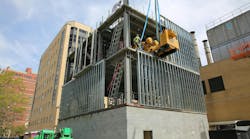Construction employment increased in 139 out of 337 metropolitan areas between December 2011 and December 2012, declined in 131 and was stagnant in 65, according to a new analysis of federal employment data released today by the Associated General Contractors of America. Association officials noted that growing private sector demand for new construction projects boosted employment in a slight plurality of metro areas.
“Private sector demand for energy, health care, higher education, and residential construction is having a positive impact in a growing number of metro areas,” said Ken Simonson, the association’s chief economist. “Unfortunately, construction employment in almost as many metro areas appears to be suffering from declining public sector demand and a private sector market that is still well-below peak levels.”
Pascagoula, Miss., added the highest percentage of new construction jobs (42%, 1,900 jobs) followed by Haverhill-North Andover-Amesbury, Mass.-N.H., (22%, 800 jobs); Lafayette, La., (17%, 1,100 jobs), and Omaha-Council Bluffs, Neb.-Iowa, (16%, 3,000 jobs). Houston-Sugar Land-Baytown, Texas, (17,600 jobs, 10%) added the most jobs. Other areas adding a large number of jobs included Dallas-Plano-Irving, Texas, (8,300 jobs, 8%); Seattle-Bellevue-Everett, Wash., (7,800 jobs, 12%); Boston-Cambridge-Quincy, Mass., (5,900 jobs, 12%) and Los Angeles-Long Beach-Glendale, Calif., (5,700 jobs, 5%).
The largest job losses were in Atlanta-Sandy Springs-Marietta, Ga., (-4,900 jobs, -5%); followed by Portland-Vancouver-Hillsboro, Ore.-Wash., (-3,600 jobs, -7%); Tampa-St. Petersburg-Clearwater, Fla., (-3,500 jobs, -7%) and Northern Virginia (-3,200 jobs, -5%). Jackson, Miss., (-20%, -2,000 jobs) lost the highest percentage. Other areas experiencing large percentage declines in construction employment included Columbus, Ind., (-19%, -300 jobs); Springfield, Mass.-Conn., (-18%, -1,400 jobs) and Danville, Ill., (-13%, -100 jobs).
Association officials noted that construction employment is benefitting from growing demand for construction, driven primarily by the private sector. They added that the rebounding housing market and relatively strong demand for health care, energy and higher education facilities boosted construction spending levels by over 7% for the year through November. But they cautioned that construction spending was still more than $300 billion below peak levels amid declining public sector activity and weaker demand for office, retail and lodging.
“Contractors in some areas appear confident enough about market conditions to begin adding staff,” said Stephen E. Sandherr, the association’s CEO. “The question is whether private sector demand will continue to grow in 2013 or stall as it has done in prior years.”


